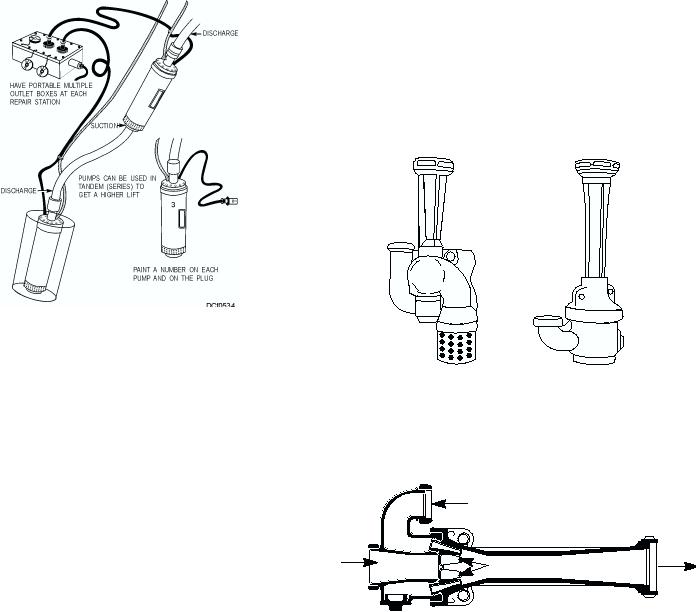
most efficiently if the water is discharged at the lowest
accomplished according to PMS and the
manufacturer's technical manual.
practicable point and if the discharge hose is short and
free from bends and kinks. When it is necessary to
PORTABLE AND FIXED EDUCTORS
dewater against a high discharge head, you can use two
submersible pumps in tandem (series), as shown in
Eductors (fig. 5-35) are jet-type pumps that
figure 5-34. The pump at the lower level lifts water to
contain no moving parts. An eductor contains jets
the suction side of the pump at the higher level. A
(sometimes called nozzles), as shown in figure 5-36,
multiple outlet connection box is used to make the
through which water flows under pressure. The
necessary electrical connections and will allow
firemain (or the P-100 fire-fighting pump) supplies the
concentration of multiple pumps in a single location.
actuation water that enters the eductor through the
supply connection. The velocity (speed) of the water
increases while flowing through these nozzles and
creates a vacuum in the suction area of the eductor. The
suction side of the eductor is connected to a
noncollapsible hose or may be submerged into a
flooded space to remove the water.
S-TYPE
PERIJET
Figure 5-34. Tandem connections for submersible pumps.
When using a submersible pump, always lower it
DCf0535
and raise it by the nylon handling line and NOT by the
Figure 5-35. Portable eductors.
electric cable. Handling the pump by the electric
cable could break the watertight seal where the cable
enters the housing. The handling line is secured to the
pump housing through an eye installed for that
purpose. It may be married to the power cable (tied
2 1/2"
together), provided considerable slack is left in the
PRESSURE
SUPPLY
cable at the pump end.
Submersible pumps are not designed to pump
3"
4"
JETS
SUCTION
DISCHARGE
gasoline or heavy oil. Since the pumped liquid
circulates around the motor as a coolant, gasoline can
DCf0536
leak into the motor and cause an explosion. If you use
a submersible pump to pump heavy oil, the motor will
burn out because the viscous liquid will impose a
heavy load on the motor. Also, a heavy, viscous liquid
Figure 5-36. Cross-sectional view of a perijet eductor.
will not dissipate heat rapidly enough to keep the
motor cool.
Eductors are used to pump liquids that cannot be
An electrical submersible pump must be carefully
pumped by other portable pumps (such as heavy oils
checked out by an electrician before use; do not wait
and flammable liquids) and are able to remove liquids
until a casualty develops to discover a malfunctioning
that contain small particles of foreign matter. The rate
pump. All repairs, testing, and maintenance must be
of dewatering will depend on actuation pressure (from
5-19

